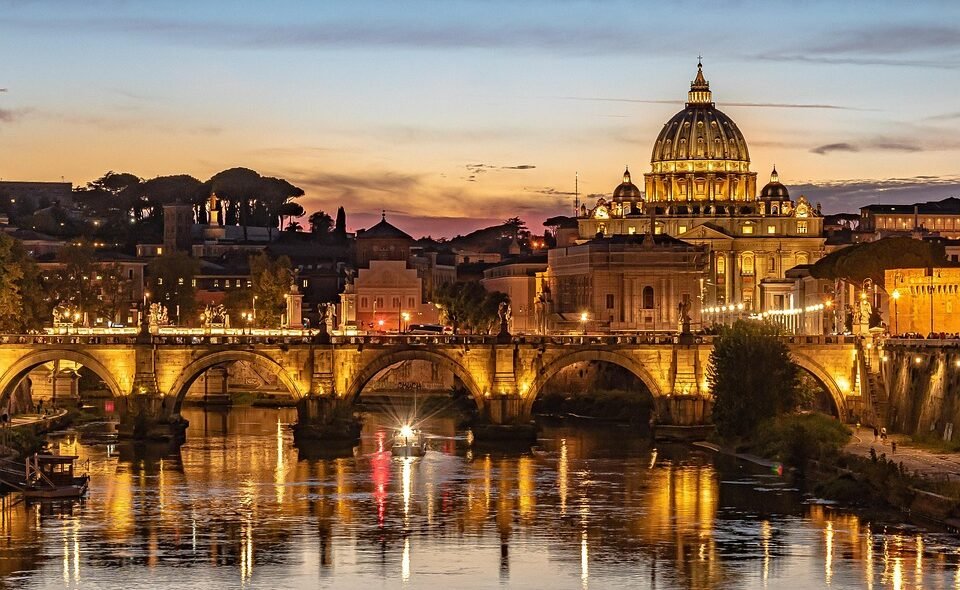Table: Summary of Information in “Unraveling Rome’s Ancient Secrets: Discovering Hidden Gems in the Eternal City”
Title: “Unraveling Rome’s Ancient Secrets: Discovering Hidden Gems in the Eternal City”
– Rome’s nickname: “the Eternal City”
– Reasons for the nickname: rich history, lasting legacy, continuous habitation for over 2,500 years, historical importance, cultural significance, survived challenges and rebuilt
Hidden Gems to Discover in Rome:
1. Aventine Keyhole: Offers unique view of St. Peter’s Basilica
2. Appian Way: Ancient road with tombs, catacombs, and landscapes
3. Basilica of San Clemente: Built upon layers of Roman history, underground archaeological site
4. Capuchin Crypt: Crypt adorned with bones of Capuchin monks
5. Protestant Cemetery: Burial ground for famous figures like John Keats and Joseph Severn
6. Mouth of Truth: Marble mask said to bite off the hand of liars
7. Palatine Hill: Breathtaking views, gardens, ruins of palaces
8. Baths of Caracalla: Ancient public baths with towering walls and mosaics
9. Janiculum Terrace: Panoramic viewpoint with stunning sunset vistas
10. Orange Garden: Tranquil garden with views of St. Peter’s Basilica
Best Time to Visit Rome:
– Spring and autumn months for mild weather and fewer crowds
– Summer for vibrant festivals and events
– Winter for fewer crowds, festive decorations, and Christmas markets
Must-Visit Historical Sites in Rome:
– Colosseum
– Roman Forum
– Pantheon
– Vatican Museums
– Trevi Fountain
– Spanish Steps
– Castel Sant’Angelo
– Catacombs of Rome
– Arch of Constantine
– Piazza Navona
Best Neighborhoods to Explore in Rome:
– Trastevere
– Monti
– Testaccio
– Navona and Pantheon
– Esquilino
– Ghetto
– Aventine
– Prati
– Campo de’ Fiori
– Ostiense
Best Day Trips from Rome:
– Vatican City
– Tivoli
– Ostia Antica
– Castelli Romani
– Orvieto
– Pompeii
Note: The table can be further expanded with additional information or divided into separate tables for each section.
Unraveling Rome’s Ancient Secrets: Discovering Hidden Gems in the Eternal City
Why is Rome known as the Eternal City?
Rome is often referred to as the Eternal City due to its rich history and lasting legacy. The city has been continuously inhabited for over 2,500 years, making it one of the oldest cities in Europe. Its historical importance and cultural significance have granted it this timeless title.
Rome was the capital of the ancient Roman Empire and served as the center of power for centuries. It witnessed the rise and fall of one of the greatest civilizations in history. Today, its majestic architecture, iconic landmarks, and ancient ruins continue to draw millions of visitors who are captivated by its timeless beauty.
Furthermore, throughout the centuries, Rome has withstood numerous challenges, including invasions, wars, and natural disasters. Yet, it has always managed to rebuild and retain its status as a prominent city, ensuring its enduring presence.
What are some hidden gems to discover in Rome?
While Rome is famous for its iconic landmarks such as the Colosseum and the Vatican, there are also lesser-known treasures waiting to be discovered:
- The Aventine Keyhole: Located on Aventine Hill, this small but mesmerizing keyhole offers a unique view of St. Peter’s Basilica through a garden.
- The Appian Way: One of the oldest and most important Roman roads, the Appian Way is lined with ancient tombs, catacombs, and picturesque landscapes.
- The Basilica of San Clemente: This remarkable church is built upon layers of Roman history, with an underground archaeological site showcasing mysterious subterranean chambers and a pagan temple.
- The Capuchin Crypt: Located beneath the Church of Santa Maria della Concezione, this crypt is adorned with the bones of Capuchin monks, creating a macabre yet fascinating display.
- The Protestant Cemetery: Also known as the Non-Catholic Cemetery, this serene burial ground houses the final resting places of renowned figures such as poet John Keats and painter Joseph Severn.
- The Mouth of Truth: Found in the Basilica of Santa Maria in Cosmedin, this ancient marble mask is said to bite off the hand of anyone who tells a lie when placing their hand inside.
- The Palatine Hill: While overshadowed by the Colosseum, the Palatine Hill offers breathtaking views, lush gardens, and the ruins of imperial palaces.
- The Baths of Caracalla: These ancient public baths house towering walls and mosaics, providing a glimpse into Rome’s opulent past.
- The Janiculum Terrace: Situated on the highest hill in Rome, this panoramic viewpoint showcases breathtaking vistas of the city, especially during sunset.
- The Orange Garden: Located on Aventine Hill, this tranquil garden offers beautiful views of the city, especially the dome of St. Peter’s Basilica.
When is the best time to visit Rome?
Rome is a city that can be enjoyed throughout the year, but the best time to visit depends on personal preferences and travel priorities.
Many travelers prefer visiting Rome during the spring and autumn months (April to June and September to November) when the weather is mild, and the city is less crowded. During these seasons, you can explore Rome comfortably without enduring the scorching summer heat or chilly winter temperatures.
Summer (June to August) is peak tourist season in Rome, and while the city is bustling with energy and events, it can be quite crowded and hot. However, if you enjoy vibrant festivals, open-air concerts, and a lively atmosphere, summer can be a great time to experience Rome.
Winter (December to February) in Rome offers fewer crowds, shorter lines at attractions, and some spectacular festive decorations. Although it may be chilly, winter also brings the opportunity to witness Rome’s enchanting Christmas markets, festive traditions, and indulge in warm Italian cuisine.
Ultimately, the best time to visit Rome will depend on your personal preferences, desired activities, and tolerance for crowds and weather conditions.
What are the must-visit historical sites in Rome?
Rome is a treasure trove of historical sites, each offering a glimpse into its ancient past and magnificent architecture. Some of the must-visit historical sites in Rome include:
- The Colosseum: Rome’s most iconic landmark, this ancient amphitheater hosted grand spectacles and gladiatorial battles.
- The Roman Forum: This sprawling archaeological site was once the center of Roman public life, filled with temples, markets, and government buildings.
- The Pantheon: A marvel of Roman engineering, this ancient temple is renowned for its massive dome and stunning interior.
- The Vatican Museums: Home to countless works of art, including the Sistine Chapel, the Vatican Museums showcase centuries of artistic excellence.
- The Trevi Fountain: One of Rome’s most famous fountains, tossing a coin into the Trevi Fountain is believed to ensure a return to Rome.
- The Spanish Steps: This iconic staircase links the Piazza di Spagna and Trinità dei Monti, providing a popular spot for locals and tourists alike.
- The Castel Sant’Angelo: Originally built as a mausoleum, this impressive fortress offers panoramic views of Rome and its history as a papal residence.
- The Catacombs of Rome: These underground burial complexes reveal early Christian art and provide insight into Rome’s early Christian community.
- The Arch of Constantine: Built to commemorate Emperor Constantine’s victory, this triumphal arch stands as a symbol of Rome’s grandeur.
- The Piazza Navona: This lively square features stunning Baroque architecture, including Bernini’s famous Fountain of the Four Rivers.
What are the best neighborhoods to explore in Rome?
Rome is a city of diverse neighborhoods, each with its own distinct character and charm. Some of the best neighborhoods to explore in Rome include:
- Trastevere: Known for its picturesque cobblestone streets and vibrant nightlife, Trastevere offers authentic Roman atmosphere, charming piazzas, and cozy trattorias.
- Monti: This trendy neighborhood is packed with artisan boutiques, hip bars, and fashionable eateries. Explore its narrow alleys and unique shops for a taste of local culture.
- Testaccio: A neighborhood loved by food enthusiasts, Testaccio is home to local markets, traditional Roman trattorias, and some of the city’s best street food.
- Navona and Pantheon: These bustling areas are known for their charming squares, lively street performances, and an abundance of restaurants and cafes.
- Esquilino: With its multicultural atmosphere and diverse food scene, Esquilino offers a taste of the world within the Eternal City. Don’t miss exploring its vibrant market, Mercato Esquilino.
- Ghetto: Rome’s Jewish Quarter is filled with history, including the ancient Portico d’Ottavia and the Great Synagogue. Discover traditional Jewish cuisine and wander through narrow streets.
- Aventine: This elegant neighborhood is known for its breathtaking views of Rome, tranquil parks, and beautiful churches. Visit the Keyhole of Rome on Aventine Hill for a unique sight.
- Prati: Located near the Vatican, Prati entices visitors with its upscale shopping streets and wide boulevards. Enjoy strolling along Via Cola di Rienzo and sampling local delicacies.
- Campo de’ Fiori: This lively square hosts a bustling market in the mornings and transforms into a vibrant nightlife hub in the evenings. Sip aperitivos and people-watch in this energetic neighborhood.
- Ostiense: Ostiense is an up-and-coming neighborhood characterized by industrial architecture, street art, and trendy bars. Explore its alternative side and discover hidden gems.
What are the best day trips from Rome?
While Rome has an abundance of attractions, taking a day trip to explore nearby destinations is highly recommended. Some of the best day trips from Rome include:
- Vatican City: Just a short distance from Rome, Vatican City is an independent city-state and the headquarters of the Roman Catholic Church. Visit St. Peter’s Basilica, the Vatican Museums, and admire Michelangelo’s masterpieces in the Sistine Chapel.
- Tivoli: Known for its stunning gardens and historic villas, Tivoli offers the opportunity to explore two UNESCO World Heritage Sites – the Renaissance Villa d’Este and the ancient Hadrian’s Villa.
- Ostia Antica: Step back in time and visit the ancient Roman city of Ostia Antica, once a thriving port town. Wander through remarkably preserved ruins, including an amphitheater, baths, and mosaics.
- Castelli Romani: Escape the city and explore the picturesque hill towns known as the Castelli Romani, including Frascati, Ariccia, and Castel Gandolfo. Discover charming squares, scenic landscapes, and indulge in regional cuisine and wines.
- Orvieto: Located in the Umbria region, Orvieto is famous for its magnificent Gothic cathedral and its underground cave network. Marvel at artworks, stroll through medieval streets, and enjoy panoramic views of the countryside.
- Pompeii: Take a journey back in time and visit the ancient city of Pompeii, which was tragically buried under the eruption of Mount Vesuvius in 79 AD. Explore remarkably preserved ruins, including theaters, villas, and Roman streets.
- Tarquinia: Delve into Etruscan history at the UNESCO-listed town of Tarquinia. Discover well-preserved Etruscan tombs, visit the National Archaeological Museum, and explore its charming medieval old town.
- Civita di Bagnoregio: Known as the “Dying Town,” Civita di Bagnoregio is a picturesque hilltop village accessible via a pedestrian bridge. Explore its narrow streets, admire the stunning views, and experience the magical ambiance of this centuries-old town.
- Frasassi Caves: Located in the Marche region, the Frasassi Caves are an underground wonderland of stalactites, stalagmites, and awe-inspiring formations. Embark on a guided tour to marvel at this natural masterpiece.
- Capri: While a bit further from Rome, a day trip to the enchanting island of Capri is well worth it. Admire the dramatic coastal landscapes, visit the famous Blue Grotto, and immerse yourself in the glamorous atmosphere.
What are some traditional Roman dishes to try?
Rome is a culinary paradise, offering a wide array of traditional dishes that reflect the city’s rich gastronomic heritage. Some must-try Roman dishes include:
- Carbonara: A classic pasta dish made with eggs, pecorino cheese, guanciale (cured pork cheek), and black pepper. The creamy sauce coats the pasta perfectly, creating a delightful combination of flavors.
- Amatriciana: Another famous pasta dish, Amatriciana features pasta with a sauce made from guanciale, tomato, pecorino cheese, and chili pepper. It’s a simple yet incredibly flavorful dish.
- Cacio e Pepe: A true Roman specialty, Cacio e Pepe consists of spaghetti tossed with pecorino cheese and black pepper. The simplicity of this dish allows the flavors to shine through.
- Supplì: A popular street food snack, supplì is a deep-fried rice ball filled with ragù sauce, mozzarella, and often other ingredients like peas or mushrooms. It’s a delicious and satisfying treat.
- Saltimbocca alla Romana: This classic Roman dish features tender veal escalopes topped with prosciutto and sage, then cooked in white wine and butter. It’s a flavorful combination that is sure to please.
- Carciofi alla Romana: Artichokes are a beloved ingredient in Roman cuisine, and this dish showcases them perfectly. The artichokes are braised with garlic, fresh herbs, and white wine until tender and full of flavor.
- Abbacchio alla Romana: This traditional Roman lamb dish is typically prepared by slow-cooking young lamb with white wine, rosemary, and garlic. The result is succulent, tender meat with a deliciously fragrant aroma.
- Tonnarelli Cacio e Pepe: Similar to regular Cacio e Pepe, this dish uses tonnarelli pasta, which is a thicker version of spaghetti. The combination of the thick pasta, pecorino cheese, and black pepper creates a truly satisfying dish.
- Maritozzo: A sweet treat, maritozzo is a traditional Roman pastry filled with whipped cream. It’s often enjoyed for breakfast or as an afternoon snack with a cup of coffee.
- Gelato: No visit to Rome would be complete without indulging in some authentic Italian gelato. With a variety of flavors to choose from, be sure to savor this creamy delight.
What are the best markets in Rome?
Rome is home to numerous vibrant markets, where locals and visitors alike can immerse themselves in the city’s culinary and cultural delights. Some of the best markets in Rome include:
- Campo de’ Fiori Market: One of the oldest markets in Rome, Campo de’ Fiori Market offers a colorful and bustling atmosphere. It features an array of fresh produce, fragrant spices, flowers, and specialty foods.
- Trionfale Market: Located near the Vatican, Trionfale Market is one of the largest food markets in Rome. Here, you can find an extensive selection of fresh fruits, vegetables, meat, cheese, and more.
- Testaccio Market: Known as a haven for food lovers, Testaccio Market showcases a wide range of local and regional products, including fresh ingredients, cured meats, cheese, wine, and even street food.
- Porta Portese Market: This sprawling flea market is a treasure trove of antiques, vintage clothes, accessories, and furniture. It’s the perfect place to find unique souvenirs and explore Rome’s eclectic side.
- Mercato di Campagna Amica: Located in the Piazza San Cosimato, this farmer’s market offers a selection of organic and locally sourced products. Discover fresh fruits,
Article Categories:Blog



